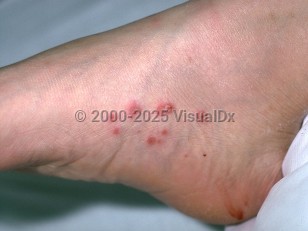Disseminated candidiasis in Child
Alerts and Notices
Important News & Links
Synopsis

Organ systems commonly affected include the kidneys, with over half of patients manifesting some form of renal involvement, which may include candiduria, hypertension, renal failure, abscess formation, and the development of fungal balls leading to obstruction and hydronephrosis. Central nervous system (CNS) involvement is also frequent, occurring in one-third of cases, and may result in abscess formation. Endophthalmitis is seen in almost half of all cases.
Cutaneous manifestations of systemic Candida infection include a generalized dermatitis, which may be followed by desquamation. Other common skin findings range from discrete pustules and erythematous or pink papules to nodules and necrotic skin. Macules may also be present. Chorioretinitis is characteristic.
Generalized symptoms include spiking fevers, chills, headache, hypotension, respiratory distress, blurred vision, and prostration. Myalgias, arthralgias, and osteoarthritis may be present. Pneumonia occurs in 70% of patients.
Systemic candidiasis is a serious illness that is associated with significant morbidity and mortality.
Candida auris is an emerging cause of candidemia that is notable for high rates of mortality and for drug resistance. Consultation with an infectious disease specialist is highly recommended when caring for patients with C auris infection.
Codes
B37.7 – Candidal sepsis
SNOMEDCT:
70572005 – Disseminated candidiasis
Look For
Subscription Required
Diagnostic Pearls
Subscription Required
Differential Diagnosis & Pitfalls

Subscription Required
Best Tests
Subscription Required
Management Pearls
Subscription Required
Therapy
Subscription Required
Drug Reaction Data
Subscription Required
References
Subscription Required
Last Updated:09/17/2025

